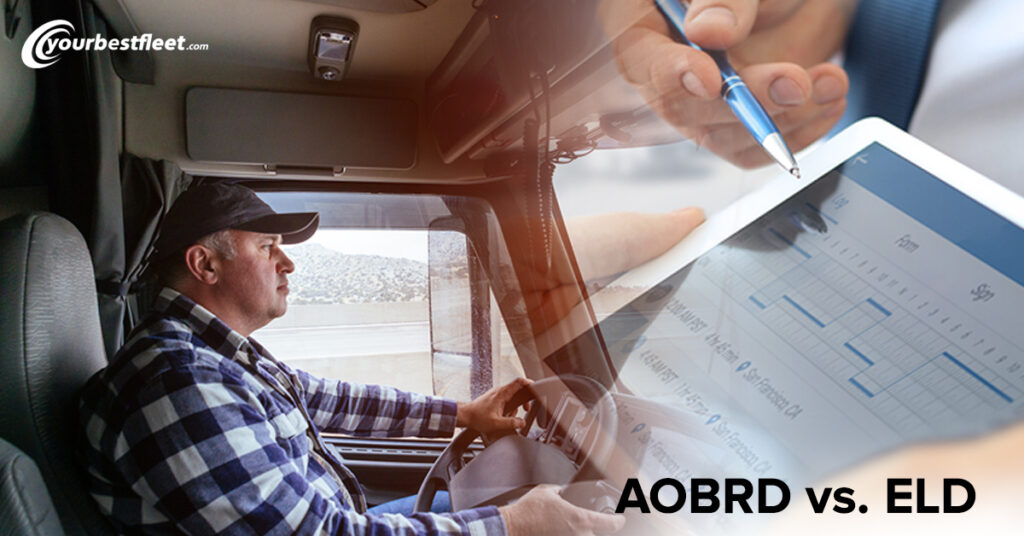In recent years, the trucking industry has shifted away from logging paper logs to digital logging solutions. This shift has been partly driven by the Federal Motor Carrier Safety Administration’s Electronic Logging Device mandate, which requires most trucking fleets to use a compliant solution for Hours of Service (HOS) tracking. While electronic logging devices are the new standard, many trucking fleets still use Automatic Onboard Recording Devices.
If your business must switch to an electronic logging device or automated onboard recording device, understanding the differences between the two technologies and how to transition from AOBRD to ELD-compliant technology is vital for all trucking fleets.
An AOBRD and ELD are electronic devices that record a driver’s Hours of Service. An ELD provides more advanced recording features that comply with the Federal Motor Carrier Safety Administration’s ELD mandate. Find out in this quick guide about AOBRD vs. ELD here!
What Is AOBRD?
An AOBRD is a device that is installed in the cab of a commercial motor vehicle and records data related to driving time, speed, location, and other vital metrics. It has been the standard for HOS tracking since the 1990s and is still used by many trucking fleets today.
An AOBRD has a display unit, which includes a clock and a keypad for manually entering data. The device is then connected to the vehicle’s engine control module (ECM) to gather data such as speed and distance traveled. The AOBRD also has a GPS receiver to track the vehicle’s location and a data logger to store the data for later retrieval.
AOBRDs have been mandatory by law since 2005 when they replaced older paper logs as an alternative method for recording HOS. The records were typically printed or kept electronically and may be inspected by Federal Motor Carrier Safety Administration agents during an inspection. The AOBRD device must be capable of displaying or printing the times of duty status changes and other required information for enforcement officers. It must also store this information for the last seven days.
Before the electronic logging device rule compliance date of December 18, 2017, the AOBRD ensured that truck drivers complied with federal safety rules for service hours. This older logging device required drivers to purchase recording hardware, which may contain some of the same features as an ELD.
What Is ELD?
Electronic logging devices record a driver’s driving time and location. They ensure compliance with the Federal Motor Carrier Safety Administration’s (FMCSA) Hours of Service (HOS) regulations. Unlike an AOBRD, an ELD is a plug-and-play device connecting to a truck’s diagnostic port and collecting data from the ECM.
ELDs enable carriers to track their drivers’ and vehicles’ hours, miles, and locations in near-real time, providing valuable insights into how the motor carrier is managed. The data collected by this device is also used to comply with other regulations, such as Vehicle Maintenance requirements. With their help, fleet carriers can better manage driver safety, reduce paperwork and improve operations efficiency.
The Key Differences Between AOBRD And ELD
While both AOBRD and ELD technologies track and record drivers’ service hours, the two have several key differences.
The most obvious difference is the technology itself. An AOBRD is a device that is installed in the cab of a commercial motor vehicle and records data related to driving time, speed, location, and other vital metrics. An ELD is a device that is installed in the cab of a commercial motor vehicle and connects to the vehicle’s engine control module (ECM) to gather data related to driving time, speed, location, and other vital metrics.
Finally, there is a difference in the time the data must be stored. An AOBRD typically stores data for a maximum of 8 days, while an ELD must store data for a minimum of 6 months.
Let us examine the distinctions between the two devices as classified by the US Department of Transportation (DOT) and the Federal Motor Carrier Safety Administration.
| Feature | AOBRD Rule | ELD Rule |
| Location Records of the CMW | Can be automatically or manually recorded and is required each time your duty status changes. | Requires automated entry at each change of duty status, every 60 minutes while the CMV is moving, while the engine is on and off, and at the start and stop of moves for personal use and yard work. |
| Communication Methods | Do not prescribe a format for transferring driver’s logs to enforcement officials. | Data must be transferred using local (USB and Bluetooth) or telematics (Web services and email) channels. |
| Graph Grid Display | The graph grid is not mandatory for the device’s display; only the time and duty status change sequence are needed. | If the transfer is impossible, the logging device must provide the enforcement officials with either Display or Printout backup choices to convey the standardized driver’s log information. |
| Automatic Record | Not required to record driving status automatically | Unless the driver chooses a particular driving category, such as a yard move or personal conveyance, the vehicle must begin to automatically record the driver’s status as it exceeds five mph. |
| Yard Move / Personal Conveyance | Not Mandatory Although certain AOBRDs include the Yard Move and Personal Conveyance statuses and classify them as Driving. | Requires the carrier to manage the support system permission for a driver to use the statuses Yard Move or Personal Conveyance. |
| Clock Time Drift | Not addressed. | The device time must be in sync with UTC; the absolute difference from UTC can be at most 10 minutes. |
You can study the comparison table published by FMCSA to ascertain whether their devices comply with the regulations because there are too many technical distinctions between the two logging devices than what is discussed in this article. Get clarification from your reliable Electronic logging device provider, such as Matrack Inc, if you need help deciding.
Should You Upgrade From Your Current AOBRD?
The ELD deadline was initially set for December 16, 2019, and then postponed until September 30, 2021. The new rules require that AOBRDs be removed from active service before December 16, 2020. If you haven’t already, it’s imperative to move to an ELD system immediately because the time for upgrading your fleet has passed.
Benefits of Choosing ELD-Compliant Technology
There are many benefits to choosing ELD-compliant technology for your trucking fleet has many benefits. The most obvious benefit is that the federal government requires it, so ensuring your fleet complies with the mandate is essential. It offers many other benefits, such as
- FMCSA-approved electronic logbook and Hours of Service (HOS) compliance.
- Real-Time alerts to improve safety and efficiency.
- Enhanced productivity and streamlined operations through GPS tracking.
- Monitor driver performance with advanced violations Warning
- Automated reporting to minimize administrative paperwork
- Automated IFTA Fuel Tax calculation and reporting
Overall, choosing this technology can help trucking companies manage their fleets more efficiently while ensuring compliance with federal regulations at all times.
How to Transition Your Fleet to ELD?
Transitioning from AOBRD to ELD-compliant technology can be daunting for many trucking fleets. Having these considerations is the key to making the transition as smooth as possible:
- The first step is to choose the suitable Electronic Logging Device for your fleet. Ensure your device is secure, reliable, easy to use, and, most importantly, DOT Compliant.
- Ensure proper installation and reliable data recording accurately.
- Provide adequate training to the drivers to use the device and understand the importance of accurately tracking and recording their service hours.
- Drivers are assured that their privacy is protected when using a compliant logging device during personal conveyance.
- Finally, you should ensure that your fleet complies with all of the requirements put forward by FMSCA, including storing data for at least six months.
- Ensure your fleet’s data is regularly inspected, and any non-compliance is addressed quickly and appropriately.
How to Choose the Right ELD for Your Fleet?
Choosing the suitable Electronic Logging Device for your fleet is an important decision that can significantly impact your business’s efficiency and profitability. Knowing which is best for you can take time and effort with so many different options on the market.
First and foremost, you should ensure that the device you choose complies with the FMCSA mandate. You should also consider the logging device’s features, capabilities, cost, and associated software or services.
Ensuring your device is compatible with your fleet’s vehicles and other systems is essential. It would help if you confirmed that the device is secure, reliable, and easy to use and understand. Finally, make sure that the logging device you choose offers good customer support so that you can get help and answers to any questions or problems.
Several options can be found if you look through the list of FMCSA-approved devices. Vendors like Matrack offer the best devices that cater to customer satisfaction ratings, convenience, features, adaptability, and cost-efficiency. These systems have several capabilities, including GPS-enabled real-time tracking, Geofencing, aggressive tracking mode, and more, and cost nothing to use.
Conclusion
Notwithstanding the potential repercussions of being caught with a non-compliant system, this is your chance to put one in place if you still need a fleet management solution.
Stay ahead of the curve with leading ELD providers like Matrack and take your business to the next level. With state-of-the-art Electronic Logging Devices that offer accurate, real-time tracking of driver hours and FMCSA compliance with Hours of Service (HOS) regulations, your business can reach new heights. Owners and operators can easily monitor driver behavior, track service hours, reduce fuel consumption, and improve the overall efficiency of their fleet. With several innovative features, most ELDs in the market eliminate paperwork and manual logging, simplify driver compliance, and seamlessly transition from AOBRD to ELD. Get the ultimate advantage in efficiency and safety & invest in an ELD today.
James Johnson is a former truck driver who now works as a writer, specializing in the trucking industry. With over 15 years of experience on the road, James has a unique perspective on the challenges and opportunities faced by truck drivers and the trucking industry as a whole. His writing focuses on issues such as safety, regulation, and the latest industry trends. His work has been featured in several trucking publications and he has received recognition for his contributions to the industry. In his free time, James still enjoys being around trucks and often attends truck shows and other industry events.


